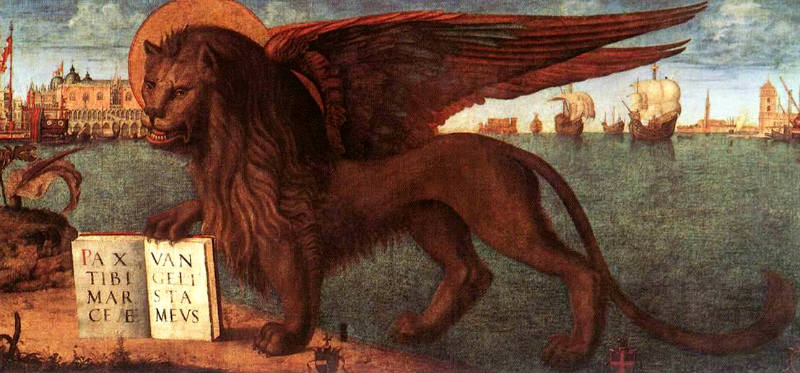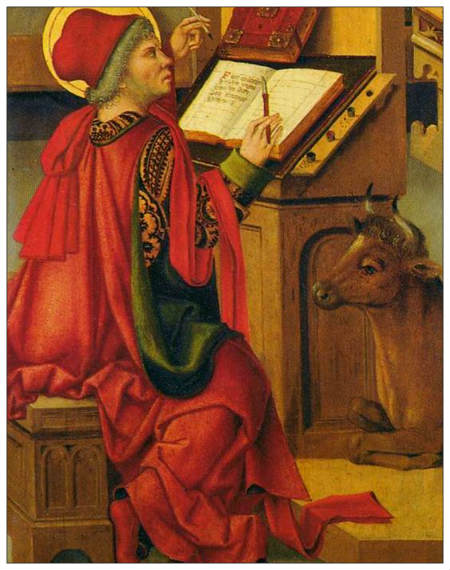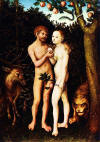Search:: Artists Alphabetically Artists by Country Artists by Century Artists by Movement
Emblems and Symbols of The Four EvangelistsIndependently of their reference to the four evangelists these figures sometimes refer to the Incarnation, the Passion, the Resurrection, and the Ascension.
Depictions of The Four Evangelists are part of a rich and very old tradition in Gothic, Early Renaissance, High Renaissanceand Northern Renaissance period. The rendering of early Christian figures were part of a rich visual language. In a time when only the clergy and the occasional nobleman could read, paintings acted as instructive stories. According to author John Vinycomb "The winged living figures, symbols of the evangelists, which are most frequently met with, and which have ever been most in favour with Early Christian artists, appear to have been used at a very early date. They are taken from the vision of Ezekiel and the Revelation of St. John. “The writings of St. Jerome,” says Audsley, “in the beginning of the fifth century gave to artists authority for the appropriation of the four creatures to the evangelists,” and for reasons which are there given at length.St. Matthew: Winged Man, Incarnation.—To St. Matthew was given the creature in human likeness, because he commences his gospel with the human generation of Christ, and because in his writings the human nature of Our Lord is more dwelt upon than the divine.
St. Mark: Winged Lion, The Resurrection.—The Lion was the symbol of St. Mark, who opens his gospel with the mission of John the Baptist, “the voice of one crying in the wilderness.” He also sets forth the royal dignity of Christ and dwells upon His power manifested in the resurrection from the dead. The lion was accepted in early times as a symbol of the resurrection because the young lion was believed always to be born dead, but was awakened to vitality by the breath, the tongue, and roaring of its sire.

The Lion of St Mark c.1516, by Vittore Carpaccio, Located at the Palazzo Ducale, Venice, Italy
St. Luke: Winged Ox, Passion.—The form of the ox, the beast of sacrifice, fitly sets forth the sacred office, and also the atonement for sin by blood, on which, in his gospel, he particularly dwells.

Saint Luke with his emblem the ox c. 16th century
St. John: The Eagle, Ascension.—The eagle was allotted to St. John because, as the eagle soars towards heaven, he soared in spirit upwards to the heaven of heavens to bring back to earth revelation of sublime and awful mysteries."
The Meaning of Sacred Symbols in Paintings. Most prominently featured symbols and their meaning:
If you feel you have worthwhile information you would like to contribute we would love to hear from you. We collect essential biographical information and artist quotes from folks all over the globe and appreciate your participation. When submitting please, if possible, site the source and provide English translation. Email to millardmulch@gmail.com
☼☼☼☼☼
Key Words, People and Principal Phrases, Characteristics Related to the Northern Renaissance Art Movement - allegorical painting, rebirth, invention of oil painting, Hieronymus Bosch, Limbourg Brothers, Desiderius Erasmus, Robert Campin, Jan Van Eyck, Jean Fouquet, Albrecht Dürer, Johannes Gutenberg, Johann Reuchlin, Martin Luther, rise of the merchant class, world landscape, Low Countries, Protestant Reformation, Calvinisim, glazing, impasto, scriptorium, illuminator, invention of the printing press, woodcuts, engravings, Antwerp School, Guild of Saint Luke, commerce, Flemish School, Northern Europe, Antwerp School, Flanders, Bruges, renewed interest in classical learning, mythological scenes, genre painting, landscapes, portraits, moralizing overtones, human vices, lust, paradise, spirituality, piousness, living a simple life, reform, Human Reasoning, tradesmen at work, idyllic scenes of peasants, playing games, feasting, linear perspective, \Heliocentric Theory, humour, satire, spiritually significant, illuminated manuscript, idealized biblical themes, scriptorium, emotion, illuminator, iconoclast, Age of Discovery, Virgin and Child, axonometric drawing, curiosity about the natural world, realistic use of colours and light, Old Testament stories, Gospel parables, The Blackdeath, Christian symbolism
☼☼☼☼☼
Search for Artists by Century Important Painters Born in the 13th Century Important Painters Born in the 14th Century Important Painters Born in the 15th Century Important Painters Born in the 16th Century Important Painters Born in the 17th Century Important Painters Born in the 18th Century Important Painters Born in the 19th Century☼☼☼☼☼
Require more facts and information about The iconographical interpretation of Symbols in Byzantine, Gothic and Renaissance Painting? Poke around every nook and cranny of the known universe for information this subject. Search Here
© HistoryofPainters.com 2017
If you like this page and wish to share it, you are welcome to link to it, with our thanks.
copyright 20003 - historyofpainters.com

